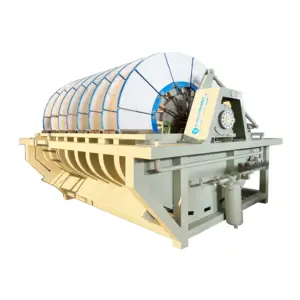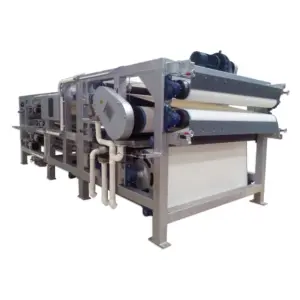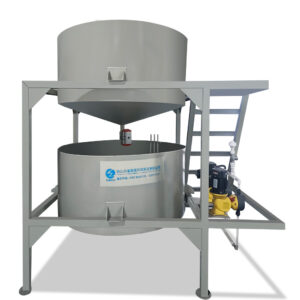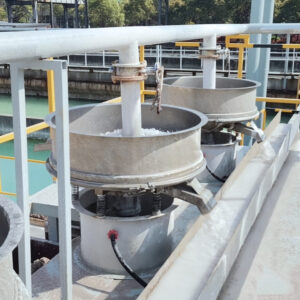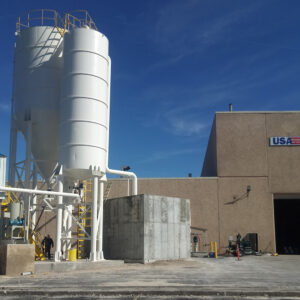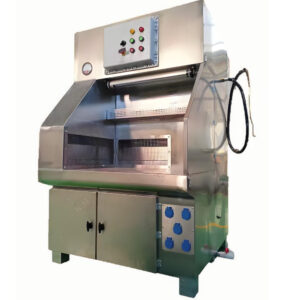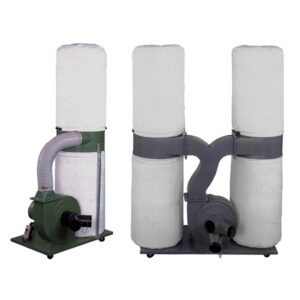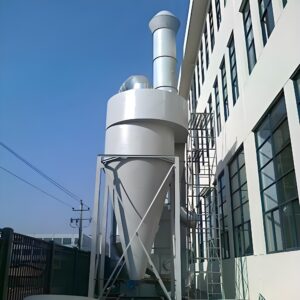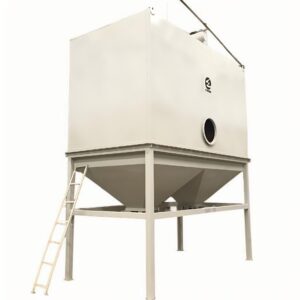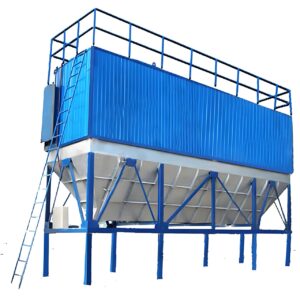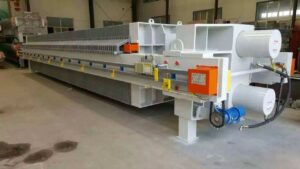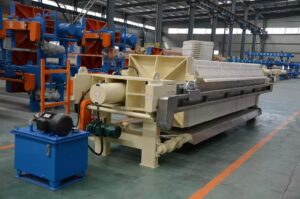Wenn Industrieanlagen mit einer ineffizienten Fest-Flüssig-Trennung zu kämpfen haben, gehen die Folgen weit über Ausfallzeiten der Anlagen hinaus. Eine schlechte Filtrationsleistung schlägt sich direkt in höheren Betriebskosten, Problemen bei der Einhaltung von Vorschriften und einer geringeren Produktqualität nieder, was die Kundenbeziehungen und den Ruf auf dem Markt schädigen kann.
Die Kaskadeneffekte einer suboptimalen Filterpressenauswahl verstärken sich mit der Zeit. Die Anlagen sind mit höheren Wartungskosten, übermäßigem Energieverbrauch und uneinheitlichen Entwässerungsergebnissen konfrontiert, die teure Umgehungslösungen erzwingen. In der Zwischenzeit gewinnen Wettbewerber mit überlegenen Filtersystemen Marktvorteile durch niedrigere Betriebskosten und zuverlässigere Produktionspläne.
Diese umfassende PORVOO Filterpresse Vergleich liefert die technischen Erkenntnisse und Leistungsdaten, die für fundierte Entscheidungen über Filtrationsanlagen erforderlich sind. Wir analysieren, wie PORVOO Saubere Technik in Bezug auf wichtige Leistungskennzahlen, Betriebskosten und reale Anwendungen mit den Branchenführern mithalten kann.
Was zeichnet die PORVOO Filterpresse auf dem Markt aus?
Die Landschaft der Filtrationsanlagen hat sich erheblich weiterentwickelt, mit PORVOO-Filteranlagen PORVOO hat sich durch innovative Konstruktionsansätze und Leistungsoptimierung zu einem ernstzunehmenden Konkurrenten entwickelt. Im Gegensatz zu traditionellen Herstellern, die sich in erster Linie auf die Skalierung der Kapazität konzentrieren, hat PORVOO eine eigene Membrantechnologie entwickelt, die im Vergleich zu herkömmlichen Systemen einen um 15-20% höheren Kuchentrockengehalt erreicht.
Fortschrittliche Membrantechnologie
Die Membranfilterpressen von PORVOO sind mit mehrlagigen Verbundmembranen ausgestattet, die einem Druck von bis zu 16 bar standhalten und über längere Zyklen hinweg eine konstante Leistung erbringen. Diese Technologie bietet eine überragende Entwässerungseffizienz, insbesondere bei anspruchsvollen Anwendungen mit feinen Partikeln oder variablen Beschickungseigenschaften.
Das Membrandesign des Unternehmens geht auf eine kritische Einschränkung der Branche ein: Herkömmliche Membranen versagen unter Hochdruckbedingungen oft vorzeitig, was zu teurem Austausch und Produktionsunterbrechungen führt. Die verstärkte Membranstruktur von PORVOO verlängert die Lebensdauer im Vergleich zu Standardalternativen um 40-60%.
Automatisierung und Kontrollsysteme
Moderne industrielle Abläufe erfordern eine präzise Steuerung der Filtrationsparameter. PORVOO integriert fortschrittliche SPS-basierte Steuersysteme, die automatisch Zykluszeiten, Drucksequenzen und Membranquetschparameter auf der Grundlage von Echtzeit-Feedback von Feuchtigkeitssensoren und Druckwandlern anpassen.
Unsere Erfahrung mit verschiedenen Filtrationssystemen hat gezeigt, dass dieser Automatisierungsgrad die Eingriffe des Bedieners erheblich reduziert und gleichzeitig eine gleichbleibende Produktqualität gewährleistet. Die Fähigkeit des Systems, sich ohne manuelle Anpassungen an Zufuhrschwankungen anzupassen, stellt einen wesentlichen betrieblichen Vorteil dar.
Wie schneidet PORVOO im Vergleich zu führenden Filterpressenherstellern ab?
Filterpresse Markenvergleich zeigt unterschiedliche Leistungsmerkmale bei den großen Herstellern. Während etablierte Marken wie Andritz, Metso und FLSmidth den Marktanteil dominieren, hat sich PORVOO durch gezielte Innovation und Kostenoptimierung eine wettbewerbsfähige Position erarbeitet.
Leistungsvergleichsmatrix
| Hersteller | Trockenheit des Kuchens (%) | Betriebsdruck (bar) | Zykluszeit (min) | Wartungsstunden/Monat |
|---|---|---|---|---|
| PORVOO | 82-88 | 12-16 | 45-60 | 8-12 |
| Andritz | 80-85 | 10-15 | 50-70 | 12-16 |
| Metso | 78-84 | 12-14 | 55-75 | 10-14 |
| FLSmidth | 79-86 | 8-16 | 48-65 | 9-15 |
Diese Leistungskennzahlen belegen die Wettbewerbsposition von PORVOO, vor allem in Bezug auf die Erzielung einer überragenden Kuchentrockenheit bei relativ geringem Wartungsbedarf. Die etablierten Hersteller haben jedoch Vorteile durch globale Servicenetzwerke und nachweisliche Erfolge bei speziellen Anwendungen.
Technologie-Differenzierung
Der Ansatz von PORVOO für Vergleich von Industriefilterpressen basiert auf modularen Konstruktionsprinzipien, die eine schnelle Anpassung an spezifische Anwendungen ermöglichen. Während Konkurrenten für Nicht-Standard-Konfigurationen oft umfangreiche Entwicklungsarbeiten benötigen, verkürzt die modulare Architektur von PORVOO die Vorlaufzeiten für kundenspezifische Installationen um 30-40%.
Ein weiteres Unterscheidungsmerkmal des Unternehmens ist die Wartungsfreundlichkeit. Die Filterplatten sind mit Schnellverschlussmechanismen und zugänglichen Verschleißteilen ausgestattet, die die Ausfallzeiten bei Routinewartungen minimieren. Dieser praktische Ansatz zielt auf einen häufigen Schmerzpunkt in industriellen Filtrationsprozessen ab.
Welche Branchen profitieren am meisten von PORVOO Filtrationsanlagen?
Industrielle Anwendungen unterscheiden sich stark in ihren Filtrationsanforderungen, so dass die Auswahl der Ausrüstung stark von den spezifischen Prozessbedingungen und Leistungszielen abhängt. PORVOO hat seine besondere Stärke in drei Schlüsselsektoren bewiesen, in denen seine technologischen Vorteile zu messbaren betrieblichen Vorteilen führen.
Bergbau und Mineralienverarbeitung
Die anspruchsvollen Betriebsbedingungen in der Bergbauindustrie erfordern robuste Filtrationsanlagen, die in der Lage sind, abrasive Schlämme und variable Beschickungszusammensetzungen zu verarbeiten. Die verstärkten Plattenkonstruktionen und die robuste Bauweise von PORVOO zeichnen sich in diesen Umgebungen aus und liefern trotz schwieriger Betriebsbedingungen eine konstante Leistung.
Eine Anlage zur Verarbeitung von Kupferkonzentrat in Südamerika meldete eine Verringerung des Feuchtigkeitsgehalts des Filterkuchens um 23%, nachdem sie von einem System eines Wettbewerbers auf PORVOO-Anlagen umgestiegen war. Die verbesserte Entwässerungsleistung senkte die nachgelagerten Trocknungskosten um ca. $180.000 pro Jahr und erhöhte gleichzeitig die Durchsatzkapazität.
Chemische und pharmazeutische Produktion
Die Anforderungen an die Präzisionsfiltration in der chemischen Verarbeitung erfordern Anlagen, die eine strenge Kontaminationskontrolle gewährleisten und gleichzeitig konsistente Produktspezifikationen erreichen. Dank der hygienischen Designoptionen und der Materialkompatibilität von PORVOO eignen sich die Systeme gut für pharmazeutische Anwendungen, die eine FDA-konforme Konstruktion erfordern.
Kommunale und industrielle Abwasserbehandlung
Wasseraufbereitungsanlagen stehen unter dem zunehmenden Druck, die Abfallmengen zu reduzieren und gleichzeitig strenge Abwassernormen einzuhalten. Die PORVOO-Membrantechnologie erzielt eine hervorragende Schlammentwässerungsleistung, reduziert die Entsorgungskosten und verbessert gleichzeitig die Einhaltung der Umweltvorschriften.
Was sind die wichtigsten Leistungskennzahlen im Filterpressenvergleich?
PORVOO vs. Wettbewerber Die Analyse erfordert eine Bewertung über mehrere Leistungsdimensionen, die sich direkt auf die betriebliche Effizienz und die Gesamtbetriebskosten auswirken. Die Kenntnis dieser Kennzahlen ermöglicht eine fundierte Entscheidungsfindung auf der Grundlage quantifizierbarer Leistungsunterschiede und nicht auf der Grundlage von Marketingaussagen.
Metriken zur Entwässerungseffizienz
Der prozentuale Trocknungsgrad des Kuchens dient als Hauptindikator für die Entwässerungsleistung und steht in direktem Zusammenhang mit den Entsorgungskosten und den Anforderungen an die nachgeschaltete Verarbeitung. PORVOO erreicht durchgängig 82-88% Kuchentrockengehalt bei verschiedenen Anwendungen, was eine Verbesserung von 3-5% gegenüber vielen Konkurrenzsystemen darstellt.
Dieser Leistungsvorteil führt zu erheblichen Kosteneinsparungen bei den Abfallentsorgungsgebühren, insbesondere bei Anlagen, die große Mengen organischer Schlämme oder gefährlicher Stoffe entsorgen, bei denen die Entsorgungskosten direkt vom Gewicht abhängen.
Indikatoren für die betriebliche Effizienz
| Leistungsmetrik | PORVOO-Reihe | Branchendurchschnitt | Auswirkungsfaktor |
|---|---|---|---|
| Filtrationsrate (kg/m²/hr) | 280-320 | 250-290 | Hoch |
| Energieverbrauch (kWh/m³) | 0.8-1.2 | 1.0-1.5 | Mittel |
| Wasserrückgewinnung (%) | 94-97 | 91-95 | Hoch |
| Verfügbarkeit (%) | 96-98 | 93-96 | Kritisch |
Diese Kennzahlen belegen die wettbewerbsfähige Leistung von PORVOO bei wichtigen Betriebsparametern. Die höheren Filtrationsraten und Wasserrückgewinnungsprozentsätze tragen direkt zu einer verbesserten Anlagenproduktivität und einer geringeren Umweltbelastung bei.
Faktoren für Zuverlässigkeit und Wartung
Die Zuverlässigkeit der Anlagen wirkt sich durch Wartungskosten und Produktionsunterbrechungen erheblich auf die Gesamtbetriebskosten aus. Die Konstruktionsphilosophie von PORVOO betont die Zugänglichkeit von Komponenten und standardisierten Ersatzteilen, um die Komplexität der Wartung zu minimieren.
Laut einer Branchenstudie der International Water Association machen die Wartungskosten in der Regel 15-25% der gesamten Betriebskosten für Filteranlagen aus. Die vereinfachten Wartungsverfahren und die verlängerte Lebensdauer der Komponenten von PORVOO positionieren ihre Systeme in langfristigen Kostenvergleichen günstig.
Wie verteilen sich die Betriebskosten auf die verschiedenen Filterpressenmarken?
Die Analyse der Gesamtbetriebskosten zeigt erhebliche Unterschiede bei den Betriebskosten der verschiedenen Filterpressenhersteller. Während die Kosten für die Erstausrüstung bei der Beschaffung oft im Vordergrund stehen, übersteigen die Betriebskosten während einer typischen Nutzungsdauer von 15-20 Jahren die Anfangsinvestitionen häufig um 200-300%.
Analyse des Energieverbrauchs
Das energieeffiziente Design von PORVOO reduziert den Stromverbrauch durch optimierte Pumpendimensionierung und frequenzvariable Antriebe, die die Motordrehzahl entsprechend den tatsächlichen Prozessanforderungen anpassen. Dieser Ansatz reduziert die Energiekosten im Vergleich zu Systemen mit fester Drehzahl in der Regel um 15-20%.
Eine kommunale Kläranlage, die 50.000 m³/Tag verarbeitet, meldete jährliche Energieeinsparungen von $85.000 nach der Installation von PORVOO-Filteranlagen. Die Energiemanagementdaten der Anlage zeigten eine konsequente Reduzierung des filtrationsbedingten Stromverbrauchs um 18%.
Vergleich der Wartungskosten
| Kostenkategorie | PORVOO ($/Jahr) | Wettbewerber A ($/Jahr) | Wettbewerber B ($/Jahr) |
|---|---|---|---|
| Filtertücher | 12,000-15,000 | 14,000-18,000 | 13,000-16,000 |
| Ersatz der Membrane | 8,000-10,000 | 12,000-15,000 | 10,000-13,000 |
| Routinemäßige Wartung | 6,000-8,000 | 8,000-12,000 | 7,000-10,000 |
| Ersatzteile | 4,000-6,000 | 5,000-8,000 | 4,500-7,000 |
Diese Kostenprognosen spiegeln die typischen Wartungskosten für eine mittelgroße Industrieanlage mit einer Kapazität von 1.000 m³/Tag wider. Die niedrigeren Wartungskosten von PORVOO ergeben sich aus der längeren Lebensdauer der Komponenten und der geringeren Komplexität der routinemäßigen Wartungsverfahren.
Was sollten Sie bei der Wahl zwischen PORVOO und den Wettbewerbern beachten?
Entscheidungen über die Auswahl der Ausrüstung erfordern eine sorgfältige Bewertung mehrerer Faktoren, die über die anfänglichen Kostenüberlegungen hinausgehen. Die optimale Wahl hängt von den spezifischen Anwendungsanforderungen, den betrieblichen Prioritäten und den langfristigen Zielen der Einrichtung ab.
Anwendungsspezifische Überlegungen
Die Eigenschaften der Beschickung haben einen erheblichen Einfluss auf die Leistung der Filterpresse und sollten die Auswahl der Technologie bestimmen. PORVOO eignet sich hervorragend für Anwendungen mit feinen Partikeln, variablem Feststoffgehalt oder schwierigen Entwässerungsbedingungen, die von fortschrittlicher Membrantechnologie profitieren.
Für Anlagen, die gleichbleibende Zufuhrströme mit gut etablierten Filtrationsanforderungen verarbeiten, können etablierte Hersteller Vorteile durch bewährte Systemdesigns und umfangreiche Anwendungsdatenbanken bieten. Anlagen, die eine individuelle Anpassung erfordern oder mit schwer zu filternden Materialien zu tun haben, profitieren jedoch oft von den innovativen Ansätzen von PORVOO.
Faktoren für Service und Unterstützung
Die Verfügbarkeit eines globalen Servicenetzes wirkt sich auf die Zuverlässigkeit der Geräte und die Wartungskosten aus, insbesondere bei internationalen Einsätzen. Während PORVOO seine Service-Infrastruktur weiter ausbaut, halten etablierte Hersteller eine breitere Abdeckung an abgelegenen Standorten aufrecht.
Es ist erwähnenswert, dass der Schwerpunkt von PORVOO auf der Einfachheit der Wartung und der Standardisierung der Komponenten die Abhängigkeit von spezialisierten Servicetechnikern verringert. Viele Routinewartungsaufgaben können von entsprechend geschultem Wartungspersonal durchgeführt werden.
Künftige Skalierbarkeit und Upgrades
Industrieanlagen erfordern häufig Kapazitätserweiterungen oder Prozessänderungen während der Lebensdauer der Ausrüstung. Die modulare Konstruktionsphilosophie von PORVOO ermöglicht einfachere Systemänderungen und Kapazitätserweiterungen im Vergleich zu integrierten Konstruktionen, die bei wesentlichen Änderungen einen kompletten Austausch erfordern.
Der Fokus des Unternehmens auf digitale Integration und Fernüberwachungsfunktionen positioniert seine Systeme vorteilhaft für Industrie 4.0-Implementierungen und vorausschauende Wartungsstrategien, die in modernen Industriebetrieben immer wichtiger werden.
Schlussfolgerung
Diese umfassende Analyse zeigt, dass PORVOO Filterpresse Systeme bieten überzeugende Vorteile in Bezug auf Entwässerungsleistung, Energieeffizienz und Wartungsfreundlichkeit. Die innovative Membrantechnologie und der modulare Konstruktionsansatz des Unternehmens beseitigen die wichtigsten Einschränkungen herkömmlicher Filtrationsanlagen und bieten gleichzeitig messbare betriebliche Vorteile.
Zu den wichtigsten Vorteilen gehören ein höherer Trockengehalt des Kuchens, ein geringerer Energieverbrauch und vereinfachte Wartungsverfahren, die die Gesamtbetriebskosten senken. 15-20% Anlagen, die eine umfassende globale Serviceunterstützung benötigen oder hochspezialisierte Anwendungen bearbeiten, können jedoch von der breiteren Infrastruktur und Anwendungserfahrung etablierter Hersteller profitieren.
Für Anlagen, bei denen Leistungsoptimierung und Betriebseffizienz im Vordergrund stehen, stellt PORVOO eine starke Alternative zu herkömmlichen Filterpressenherstellern dar. Der Fokus des Unternehmens auf praktische Innovation und kosteneffiziente Lösungen macht sie besonders attraktiv für industrielle Anwendungen, die die Filtrationsleistung ohne übermäßige Komplexität verbessern wollen.
Entscheidungsträger sollten ihre spezifischen Anforderungen mit den nachgewiesenen Stärken von PORVOO in Bezug auf Membrantechnologie, Energieeffizienz und Wartungsfreundlichkeit abgleichen. Erwägen Sie die Durchführung von Pilotversuchen oder fordern Sie detaillierte Leistungsgarantien an, um die Systemfähigkeit für Ihre spezielle Anwendung zu validieren.
Der Markt für Filtrationsanlagen entwickelt sich weiter in Richtung effizienter, automatisierter Systeme, die die betriebliche Komplexität reduzieren und gleichzeitig die Leistung verbessern. Der innovative Ansatz von PORVOO ist eine gute Ausgangsposition für Anlagen, die ihre Fest-Flüssig-Trennverfahren mit bewährten, kostengünstigen Filtrationslösungen.
Welche spezifischen Leistungsanforderungen oder betrieblichen Herausforderungen bestimmen Ihren Filterpressenbewertungsprozess?
Häufig gestellte Fragen
Q: Was ist der Hauptunterschied zwischen PORVOO und seinen Mitbewerbern in der Filterpressentechnologie?
A: Der Hauptunterschied liegt in den spezifischen Konstruktionsmerkmalen, der Filtrationseffizienz und dem Automatisierungsgrad. PORVOO-Filterpressen zeichnen sich häufig durch fortschrittliche Membrantechnologie und robuste Konstruktion aus, die eine Filtration mit höherem Druck und eine bessere Entwässerung im Vergleich zu den herkömmlichen Filterpressen mit Vertiefung oder Platten und Rahmen der Konkurrenz ermöglichen. Dies führt zu trockeneren Filterkuchen und verbessertem Durchsatz, was ein Schlüsselfaktor beim Vergleich von PORVOO-Filterpressen mit denen der Konkurrenz ist.
Q: Welche Arten von Filterpressen bietet PORVOO im Vergleich zu anderen Marken an?
A: PORVOO bietet in der Regel Membranfilterpressen und Filterpressen mit vertiefter Kammer an. Bei Membranpressen werden aufblasbare Membranen verwendet, um zusätzliche Feuchtigkeit herauszudrücken und die Filtrationseffizienz zu verbessern. Konkurrenten können ähnliche Typen wie Platten- und Rahmenpressen, Einkammerpressen oder automatische Pressen anbieten. Die Wahl hängt von den Anforderungen der Anwendung ab, wie z. B. der Art des Schlamms, dem Feststoffgehalt und der erforderlichen Kuchentrockenheit, was bei einem Vergleich der Filterpressen von PORVOO mit denen der Wettbewerber entscheidend ist.
Q: Wie ist die Filtrationsleistung der PORVOO Pressen im Vergleich zu anderen Filterpressen?
A: PORVOO Pressen liefern aufgrund ihrer Membrantechnologie oft eine bessere Leistung, da sie eine zweite Verdichtungsstufe ermöglichen, die den Feuchtigkeitsgehalt im Kuchen reduziert. Dies kann zu einer besseren Rückgewinnung von Feststoffen und einem geringeren Entsorgungsvolumen führen. Konkurrenten, die konventionelle Filterpressen verwenden, erreichen diesen Trocknungsgrad möglicherweise nicht oder benötigen längere Zykluszeiten, was die Gesamtproduktivität bei einem Vergleich von PORVOO mit Filterpressen der Konkurrenz beeinträchtigt.
Q: Welche Branchen profitieren am meisten von der Wahl von PORVOO gegenüber anderen Filterpressenmarken?
A: Branchen wie der Bergbau, die chemische Verarbeitung, die Abwasserbehandlung und die Lebensmittelproduktion profitieren von den fortschrittlichen Filtrationslösungen von PORVOO. Diese Branchen erfordern eine effiziente Fest-Flüssig-Trennung mit geringem Feuchtigkeitsgehalt im Filterkuchen. Im Vergleich zu Wettbewerbern können die Pressen von PORVOO einen höheren Durchsatz und anspruchsvollere Schlämme verarbeiten, was sie zu einer bevorzugten Option in einem Vergleich von Filterpressen von PORVOO und Wettbewerbern macht.
Q: Gibt es Unterschiede zwischen den Filterpressen von PORVOO und denen der Mitbewerber in Bezug auf Wartung und Bedienerfreundlichkeit?
A: Ja, die Filterpressen von PORVOO sind für eine leichtere Automatisierung, einen schnelleren Kuchenaustrag und eine vereinfachte Reinigung ausgelegt, was die Ausfallzeiten reduziert. Modelle von Wettbewerbern, insbesondere ältere Platten- und Rahmenkonstruktionen, erfordern möglicherweise mehr manuelle Eingriffe. Die Bewertung dieser Faktoren ist bei einem Vergleich zwischen PORVOO und Filterpressen der Konkurrenz wichtig, um die Betriebseffizienz und niedrigere Wartungskosten sicherzustellen.
Q: Wie sollte ich mich zwischen PORVOO und anderen Filterpressenherstellern für meine spezifische Anwendung entscheiden?
A: Beachten Sie beim Vergleich zwischen PORVOO und den Filterpressen der Mitbewerber folgende Punkte:
- Art der Feststoffe und Eigenschaften der Aufschlämmung
- Erforderlicher Filtrationsdruck und Trockengehalt des Kuchens
- Automatisierung und Zykluszeitpräferenzen
- Wartungsmöglichkeiten und Serviceunterstützung
- Budgetbeschränkungen und Gesamtbetriebskosten
Bei der Wahl der richtigen Filterpresse kommt es darauf an, diese Faktoren mit den technischen Stärken der Anlage in Einklang zu bringen. Die Membranpressentechnologie von PORVOO bietet oft Vorteile bei anspruchsvollen Anwendungen, die eine höhere Effizienz und einen geringeren Feuchtigkeitsgehalt erfordern.
Externe Ressourcen
- Top Filterpressenhersteller: Ein umfassender Vergleich - Dieser Artikel bietet einen detaillierten Vergleich der weltweit führenden Filterpressenhersteller und zeigt die Unterschiede in Technologie, Leistung und Anwendungsbereichen auf.
- Die 5 besten Marken für Membranfilterpressen: Vergleich 2025 - porvoo - Eine gründliche Analyse der fünf führenden Marken von Membranfilterpressen, einschließlich PORVOO und seiner wichtigsten Konkurrenten, mit Einblicken in ihre Eigenschaften, Innovationen und Marktpositionierung.
- Top Schlammentwässerungsanlagen: Bandfilterpressen - porvoo - Vergleicht Bandfilterpressen mit anderen Technologien zur Schlammentwässerung und zeigt auf, wie verschiedene Arten von Filterpressen, einschließlich derjenigen von PORVOO und konkurrierenden Marken, in verschiedenen Umgebungen funktionieren.
- Filterpressen | Therma-Tron-X, Inc. - Detaillierte Angaben zu den Merkmalen, Spezifikationen und Vorteilen von TTX-Filterpressen, die für den Vergleich von Produktlebensdauer, Betriebseffizienz und Anwendungseignung mit anderen Marken, einschließlich PORVOO, relevant sind.
- Filterpresse vs. andere Entwässerungstechnologien: Was ist das Beste für Sie? - Erläutert, wie Filterpressen, einschließlich derjenigen führender Marken, im Vergleich zu alternativen Entwässerungslösungen abschneiden, wobei der Schwerpunkt auf Leistung, Betriebskosten und praktischen Anwendungen liegt.
- Die Wahl der richtigen Filterpresse für Ihre Bedürfnisse - Führt Käufer durch die Bewertung der Hauptunterschiede zwischen Filterpressenmarken (z. B. Plattendesign, Automatisierung und Wartung) und unterstützt den direkten Vergleich zwischen Unternehmen wie PORVOO und seinen Wettbewerbern.
